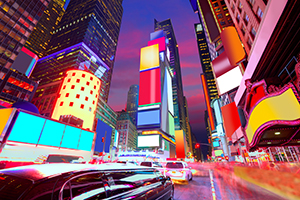Are Digital Billboards too Bright?
To compete in this landscape and gain attention, many marketers have begun to convert their billboards into a digital format. These screens display bright, attention-grabbing graphics and rotate the advertisements so that one billboard can be used for multiple clients. However, there is a very real danger in using these digital signs which must not be overlooked by advertisers: the threat of harm caused by getting – and keeping – a driver’s attention for too long.
To help address these concerns, the use of a reputable and reliable luminance and color meter becomes a helpful tool. Konica Minolta Sensing’s CS-150 Luminance meter is an instrument that can be used to ensure that digital billboards aren’t too bright but at the same time are still effective at getting the advertiser’s message across.
Outdoor, digital, billboards must be illuminated to achieve two primary goals: first, they must grab the audience’s attention from a distance to block out competing ads and, second, they must be bright enough to be both pleasing to see and easy to read. These goals compete with the goal of safety because, research has shown that keeping a driver’s attention for more than 2 seconds, dramatically increase the chances of an accident. Furthermore, there is the risk of impairing a driver’s night vision when these signs are illuminated at night and make it more difficult for the driver to focus on traffic and road signs. To address this issue, advertisers are employing light meters to ensure that their signs are easily read, visible and not distracting to motorists. There are several ways that advertisers can include light sensing technology in their outdoor advertisements which address both day and night driving conditions:
- One can use a light meter, such as Konica Minolta Sensing’s CS-150 luminance and color meter to calibrate a digital billboard for optimal brightness during the day. Most digital displays perform poorly in direct sunlight so it’s important that light meters be employed during the testing phase so that they can ensure billboards produce enough light to be visible when they are exposed to direct sunlight.
- However, in the evening, as light levels begin to dim, these same settings would produce images that are too bright which would create unsafe conditions for drivers. In addition, it also wastes electricity, cause unnecessary wear on the display due to increased heat making the sign unreadable.
- The value of light meters can also be seen in properly calibrating displays for nighttime conditions. A light meter can be used to ensure that the brightness of the billboard doesn’t compete with the lights from other driver’s cars or with road signs and other safety or road hazard communication systems. Konica Minolta Sensing’s CS-150 luminance and color meter is one such meter that can assist with this issue. The CS-150 is a highly accurate color and luminance meter that measures nearly any type of light source, indoors or outdoors. The CS-150 is incredibly precise, designed for portability, and minimizes measurement time. It is a highly accurate tristimulus colorimeter equipped with newly designed sensors that more closely match the CIE 1931 color-matching functions representing the sensitivity of the human eye to provide measurement results that better correlate with visual evaluation. Regardless of the conditions and uses, a digital billboard must not only work as a cost-effective means of promotion and communication, but it also must operate within legally mandated safety guidelines. These guidelines exist to make sure digital billboards are operated safely and do not pose a threat to the safety of commuters. Light meters help digital billboard manufacturers and operators calibrate and adjust the brightness of their products so that their messages are clear and bright but do not pose a safety risk to the public.
Learn more about Konica Minolta Sensing full line of light and display instruments available for use in the Display Industry and Lighting Industry.











